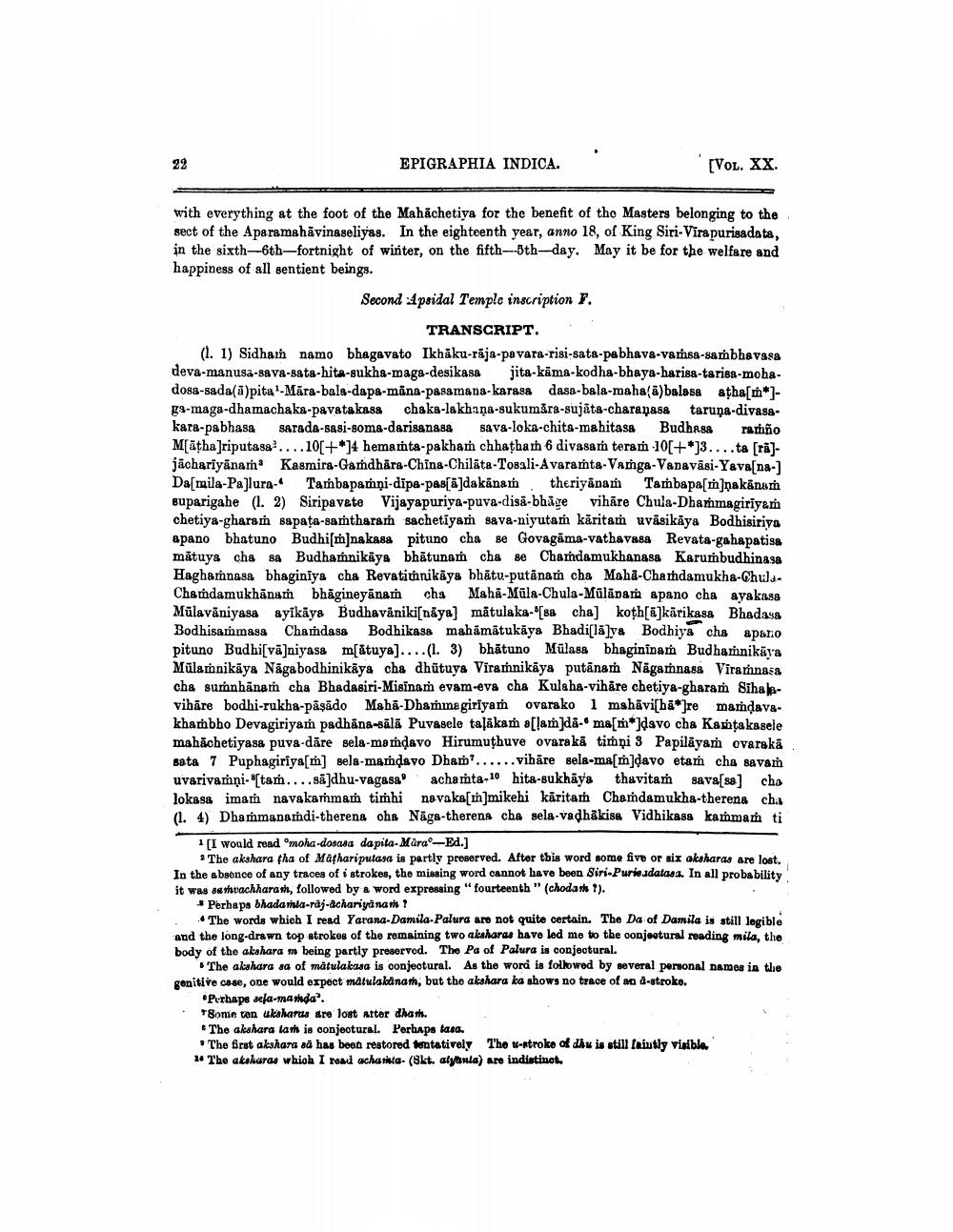________________
22
EPIGRAPHIA INDICA.
[Vol. XX.
with everything at the foot of the Mahāchetiya for the benefit of the Masters belonging to the sect of the Aparamahāvinaseliyas. In the eighteenth year, anno 18, of King Siri-Virapurisadata, in the sixth-6th-fortnight of winter, on the fifth-5th-day. May it be for the welfare and happiness of all sentient beings.
Second :Apsidal Temple inscription F.
TRANSCRIPT. (1.1) Sidhai namo bhagavato Ikhāku-rāja-pavara-risi-sata-pabhava-vamsa-sambhavasa deva-manusa-sava-sata-hita-sukha-maga-desikasa jita-kāma-kodha-bhaya-harisa-tarisa-mohadosa-sada(ā)pita --Māra-bala-dapa-māna-pasamana-karasa dasa-bala-maha(a)balesa atha[**]ga-maga-dhamachaka-pavatakasa chaka-lakhaņa-sukumăra-sujāta-charaṇase taruna-divasakara-pabhasa sarada-sasi-soma-darisanasa sava-loka-chita-mahitasa Budhasa ramño M[ätha]riputasa?....10[+*]4 hemanta-pakban chhathah 6 divasam teram 10[+*]3....ta [ra]jachariyanar Kasmira-Gamdhāra-China-Chilāta-Tosali-Avaramta-Vamga-Vanaväsi-Yava[na-1 Da[mila-Pallura Tambapamni-dipa-passă]dakānam. theriyanan Tambapa[m]nakanam Buparigahe (1.2) Siripavete Vijayapuriya-puva-disa-bhāge vihāre Chula-Dhammagiriyer chetiya-gharam sapata-samtharam sachetiyam sava-niyutam kāritam uvāsikāya Bodhisiriya apano bhatuno Budhi[m]nakasa pituno chase Govagama-vathavasa Revata-gahapatisa mätuya cha sa Budhamnikāya bhātunam cha se Chardamukhanasa Karumbudhinasa Haghamnasa bhaginiya cha Revatitnikāya bhātu-putānam cha Maha-Charhdamukha-ChulaChardamukhānum bhāgineyānam chs Mahā-Müla-Chula-Mūlādam apano cha ayakaga Mūlavāniyasa ayikāya Budhavåniki[naya) mätulaka-'[88 cha) koth[2]kārikasa Bhadaya Bodhisammaga Chandasa Bodhikasa mahämātukāya Bhadi[la]ya Bodhiya cha apario pituno Budhisvälniyasa ms&tuya)....(1.3) bhātuno Mülasa bhagininam Budharnikava Mülamnikāya Näga bodhinikāya cha dhūtuya Viramnikāya putānam Nägamnasa Viranasa cha sumnhānam cha Bhadasiri-Misinam evam-eva cha Kulaha-vihare chetiya-gharam Sihalevibāre bodhi-rukha-pāşādo Maha-Dhamma giriyam ovarako 1 mahāvisbä*]re mandavakhambho Devagiriyam padhāna-sālā Puvasele taļākam alam]da- ma[m*]davo cha Kamtakasele mahāchetiyasa puva-dāre sela-momdavo Hirumuthuve ovarakā timņi 3 Papilāyam ovarskā sata 7 Puphagiriya[m] sela-mamdavo Dham ......vibāre sela-ma[m]davo eta cha savam uvarivamņi."(tam....sa]dhu-vagasa achamta 10 hita-sukhāya thavitam sava[se] cho lokasa imam navakaṁmam timhi navaka[u]mikehi käritam Chardamukha-therena cha (1.4) Dharmanamdi-therena oha Näga-therena cha sela-vadhakisa Vidhikass kamman ti
1 [I would read moha-dosasa da pita-Müra-Ed.]
* The akshara tha of Mathariputasa is partly preserved. After this word some five or six aksharas are lost. In the absence of any traces of i strokes, the missing word cannot have been Siri-Purisadatasa. In all probability it was aarhuachharan, followed by a word expressing " fourteenth " (chodan ?).
Perhaps bhadamla-raj-achariyanan ?
The words which I read Yarana-Damila-Palura are not quite certain. The Da of Damila is still logible and the long-drawn top strokes of the remaining two akshares have led me to the conjectural reading mila, the body of the akshara n being partly preserved. The Pa of Palura is conjectural.
The akahara sa of måtulakasa is conjectural. As the word is followed by several personal names in the genitive case, one would expect matulakanath, but the akshara ka shows no trace of a d-stroke.
Purhaps sela-manda. Tome ton uksharts are lost after dhath. • The akshara lam is conjectural. Perhaps lasa.
The first akshara ad has been restored tentatively The t-stroke of dhu is still faintly visible 1. The akskuras which I read achatinda- (8Lt. alyaula) are indistincte




